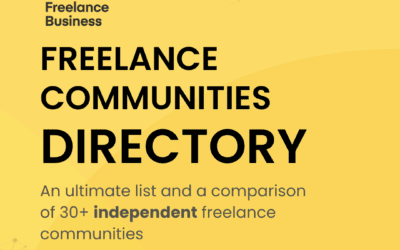The Future of Work is a trendy term that has been buzzing around for years. And while we were all waiting for robots to take over, change happened almost in a fortnight. Little did we know that when the pandemic hit us all hard globally, the change would be profound and accelerated, even in those industries that never deemed it possible. All thanks to the power of digitalization and the internet… and the adoption of the human being. Just think about having a virtual appointment with your general practitioner before the crisis… not possible right? And were you also one of those employees who never felt a need to use programs like Zoom or Teams, how often do you now use them (with video!)? In a matter of weeks, workshops or conferences for which we all paid heavily to see the next business guru take the stage live went virtual. We still paid the same. This was the closest possibility to attend events, network, to exchange ideas. And people started to think…
I was also one of those people who started to think. Now I am faced with a crisis that apparently only happens once every 100 years and had to happen in my lifetime, so what do I want to achieve with my life? What change do I want to make? What impact do I make and what vision do I have? What happened to my childhood dreams of a fair and equal society with equal chances for everyone in an environment where your talents as an individual are seen, recognized, and valued? I knew that I needed to be able to finally share my own vision, my opinion, and my drive to make it happen… by becoming a freelancer.
Freelance Business
Just like so many other employees during the pandemic, I became a hybrid entrepreneur, which in my case meant that as a freelancer I started my own company ‘Sparkling Gems’ next to my regular job. Sparkling Gems is a company that provides strategic advice and co-creation workshops in bringing diversity and inclusion closer to the (virtual) work floor. Making an impact as an entrepreneur because I care about equal chances and opportunities for all and about figuring out my life path by pivoting to new things – in this case, entrepreneurship. And I am not the only one. HR practitioners who work in Talent Acquisition have to seriously look at their workforce and how the pandemics will change this. More people like myself will start freelancing full-time or part-time and being a freelancer as part of the workforce community will become more common (although, was a job for life even still a thing?).

Five vital trends for the virtual workforce of the future
Thus, having freelancers as part of your workforce and part of your strategic workforce planning changes the field. Plus, the values by which companies live and more importantly acting on those values is a huge thing that is more and more valued by employees. Also in this, I am not the only one. And to back that up with a little research, I want to highlight a couple of trends, according to the Harvard Business Review. I will focus on those trends most relevant to working with freelancers.
1. Employers will look to acquire temporary talent to fill the skills gap
According to research by HBR companies listed 33% more skills in 2020 than they did in 2017. And some of these skills are temporarily needed, like in the case of a merger or acquisition. Thus, this is a typical example where freelancers come in place which could be by paying a premium for needed skills or partnering with organizations to shortly rent employees.
2. Employers will shift from managing the employee experience to managing the life experience of their employees
While seeing cats, dogs, spouses, abstract paintings, and more cats on video conferences may seem quite random, it gave us all an opportunity to look into the private life of our co-workers. All of a sudden employees were not just an employee but also a mother, a partner, a plant-lover, and many other things. In some sense virtual working humanized us, it showed parts of the other roles that we fulfill other than just being an employee. And this is good news for freelancers. How many times I have seen freelancers missing the invitation for the Christmas party or the Christmas gift (apparently not budgeted). By focusing on the human side freelancers are seen as equal contributors to the workforce, just like it should be. And this is really good news, not just for the spirit of the Christmas party but also for the physical and mental well-being of everyone. The feeling of inclusion and ultimately the feeling of belonging.
3. More companies will adopt stances on current societal and political debates
Last year was memorable for good and bad reasons. One of the reasons which really sparked a debate globally was of course Black Life Matters. As indicated by a Gartner survey, not only do employees expect the organizations they work for to be actively involved in actual societal debates, but they also expect their employer to act on it. This need is so strong that it makes the engagement level of the employees surveyed increase from 40% to 60%.
4. Flexibility will change from location to time
By working remotely, sitting every day in the office for 40 hours a week will probably not return for most people. Not while our mental and physicalwell-being has been improved by being able to go to the gym in the morning, take a walk after a heated discussion, and being able to spend more time with our families. And what works is very personal. Looking at the polls on LinkedIn most people will expect to partly work from home and partly in the office. The office will become more of a clubhouse, a place to meet, mingle, and exchange ideas. To find inspiration. This according to HBR will also have implications for how we are being rewarded, leading to a reward by output instead of agreed hours. Although I am a bit skeptical about this one considering Dutch labor regulations, I do think that the takeaway here is the virtual or hybrid culture this will bring to an organization. And with this come the challenges of inclusion and diversity even more.
5. Formulating and adopting a ‘Diversity and Inclusion’ policy as part of the well-being of your workforce
OK, so this one is strictly speaking not from HBR but inspired by them. I truly think that looking at the changes in the workforce accelerated by the pandemic, the changes in the way we work, and the changes in what is being expected from an employer and member of the workforce (using the most inclusive terminology here) the role of inclusion and diversity on the work floor is becoming urgent. Inclusion on the (virtual) work floor is not a nice-to-have but a good business case for attracting, retaining, and developing your talent. Whether that talent is on a permanent or flexible basis working for you. Looking at the aspirations of most organizations, it is to be the most innovative, having the highest agility, the greatest engagement… these aspirations require very complex skills which can only be obtained by great teamwork where the team is composed out of individuals together adding to cognitive diversity.
Cognitive diversity = diversity on differences in perspectives, insights, experiences, and thought patterns.
Looking at freelancers, that means the fresh perspective we bring, the new insights, and experiences from other clients and projects. In other words, do you want to embrace the Future of Work? Start with hiring more freelancers!
Inclusive greetings,
Ashmita Krishna Sharma – owner and creative strategist at Sparkling Gems. Do you have something valuable to share with other freelancers? If you’re interested in writing a guest blog post, contact us at: info@freelancebusiness.eu.




